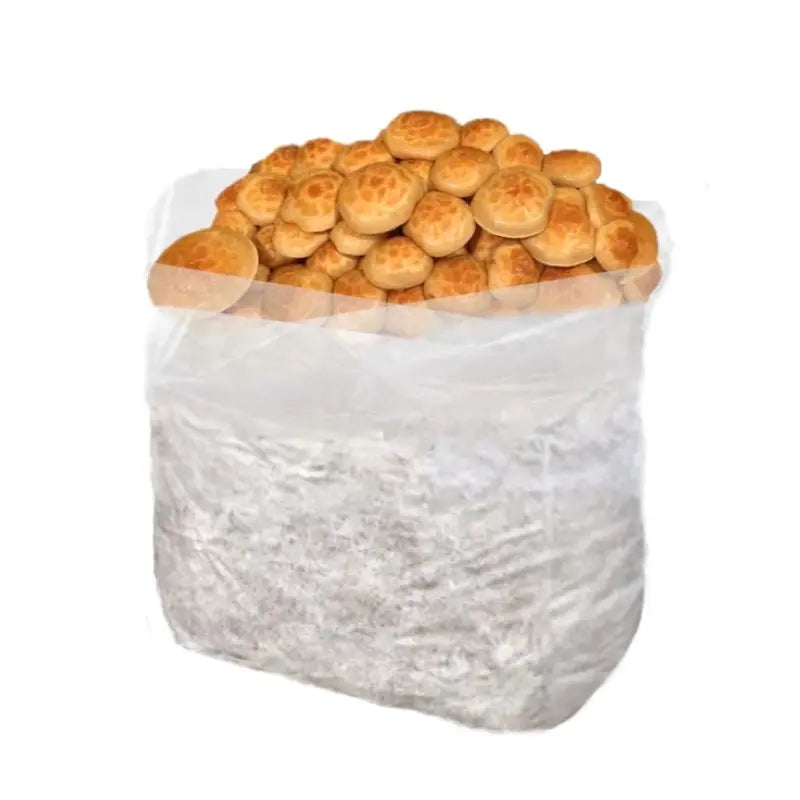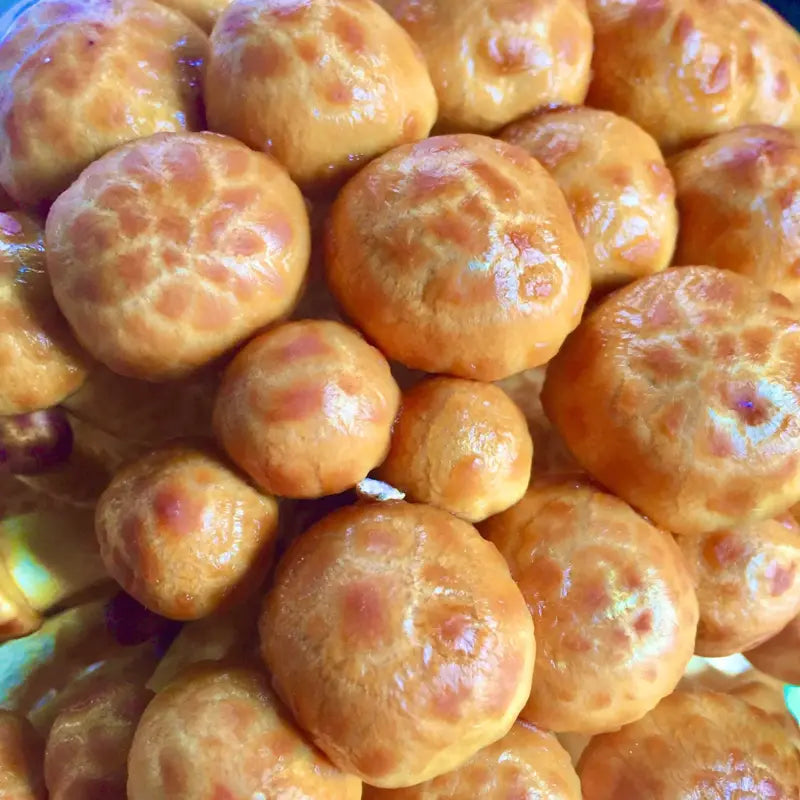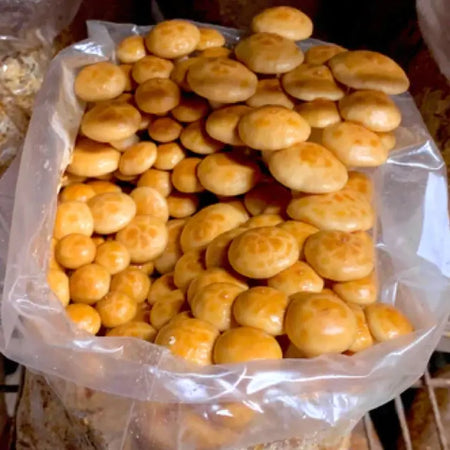NORTH SPORE Nameko
Mushroom Grow Kit Fruiting Block
Nameko (Pholiota nameko) is a popular cultivated mushroom in Japan. As they grow, they are covered in a layer of natural gelatin, which gives them a unique, almost shiny appearance. When cooked, they have an earthy flavor with subtle fruit-like hints, and an aroma reminiscent of cashews and butterscotch.
Nameko mushroom kits, though reliable, require extra attention and time to produce mushrooms. Because they need cooler temperatures and constant humidity when fruiting, they are more difficult to cultivate. They are not ideal for beginners, but can be quite rewarding for experienced growers. Using a humidity tent or humidity-controlled fruiting chamber will help mitigate moisture issues as long as there is proper gas exchange.
|
Skill level
|
Advanced
|
|
Grow location
|
Indoors
|
|
Grow speed
|
2 to 3 weeks
|
|
Shelf life
|
6 months (refrigerated)
|
|
Flavor profile
|
Sweet, earthy
|
|
Kit dimensions
|
6in H x 9in W x 6in D
|
|
Kit weight
|
5 lbs
|
Instructions:
-
Your Nameko fruiting block kit is an amended sawdust block that has been completely colonized by Nameko mushroom mycelium. Cut off the top of the bag, leaving sidewalls approximately 4” tall. If slow to pin, disturb the top 1/4” of the mycelium by using a clean tool such as a knife or wire brush to scratch the surface. The Nameko mushroom mycelium will sense the oxygen in the air and produce mushroom ‘pins’, another word for ‘baby mushrooms’. This should begin to happen within three weeks of slicing your bag. Nameko likes cooler temperatures within the 55-65F degree range.
-
Nameko loves lots of humidity and moisture but also needs ventilation to grow to full size. Place your kit in the most humid part of your home and outside of direct sunlight. We suggest putting your bag on a kitchen counter somewhat close to a sink. If your home is really dry, you may want to make a humidity tent to place over your bag. Simply take a trash bag or other loosely fitting plastic bag and put PLENTY of 1/2 inch holes in it. THIS IS IMPORTANT: Mushrooms exhale CO2 and inhale oxygen. They will suffocate themselves if there isn’t adequate airflow! Nameko that look stringy or strange are usually growing that way because they need more air! Spray the outside of your block near the slice at least once per day. If you choose to use a humidity tent make sure to spray the inside of the tent once per day to maintain humidity. With Nameko, the more humid and well-maintained the moisture, the better.
- Harvest your mushrooms when they resemble the photograph on the front of your kit! Harvest before the caps flatten out and become concave. Mushrooms grow quickly, so when you spot your first mushroom pins keep a close eye on them. The warmer the environment the faster they will grow. Mushrooms should be ready to harvest 5-10 days after pin formation. Nameko creates a gelatinous surface on its caps; this is normal and one of the features that makes Nameko unique!
- Nameko is a reliable first harvest producer. Second harvests are difficult though not impossible. Harvests usually diminish in size with each consecutive fruiting. We recommend giving your block a one week break between fruitings, leaving it alone without watering. Soak your block in cold water for 20 minutes, and then re-start the process of spraying your blocks with water daily!
⮕ Click for printable instructions
Temp, Humidity & CO2 guide
|
Fruiting temps
|
45-65 degrees F
|
|
Humidity
|
88-95%
|
|
CO2 Sensitivity
|
<1,000 ppm
|
- Fruiting - The phase of growth in which visible mushrooms begin to appear.
- CO2 sensitivity - When CO2 levels are too high, yields will decrease, stems will become long and stringy, caps will be small, and/or growth will halt.
Storing:
If you don't plan to use immediately, you can refrigerate your block for up to 6 months.
Cooking:
Nameko is a lesser known culinary mushroom in the Americas, but it is used widely in East Asia. It has a gelatinous cap that can thicken soups and sauces and an aroma that walks the line of being both fruity and earthy. Nameko mushrooms go well with dark green vegetables, red meats, and shallots, and are used traditionally in Japanese miso soups.
Ingredients:
Spawn used in our fruiting blocks is grown on USDA certified organic grain and made with organic cultures from our own culture bank. Our fruiting blocks are handmade from a blend of locally sourced, all-natural, organic, and non-GMO woods and supplements from farms and forests in New England and North America.
Creating a humidity tent:
If your home is really dry you may want to make a humidity tent to place over your bag. Simply take a trash bag or other loosely fitting plastic bag, put PLENTY of 1/2 inch holes in it. (THIS IS IMPORTANT mushrooms exhale CO2 and inhale Oxygen. They will suffocate themselves if there isn’t adequate airflow! Nameko that look stringy or strange are usually growing that way because they need more air!)
Cautions & Considerations:
If you’re going to consume home-grown mushrooms, make sure to cook your fresh mushrooms thoroughly with heat. If it is your first time eating this species, it is best to start with a small amount to check for allergies, even if cooked.
Mushrooms grow spores as they develop. This is a natural means of reproduction. This is when people with allergies or compromised immune systems may want to consider putting fruiting mushroom kits outdoors or in a well-ventilated area. Spores in mushrooms sometimes cause respiratory irritation. In rare cases, spores may also cause irritation for some non-allergic or non-immunocompromised mushroom growers. If you are one of them, it is recommended to reduce the overall spore load by harvesting mushrooms while they are still in their younger growth stages.












